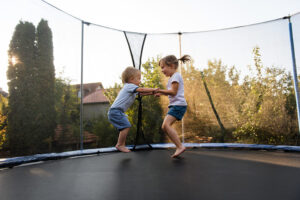We’ve encountered numerous situations where children experience feelings of anxiety or anger. These emotions are natural responses to various stressors in their lives, but as adults, it’s our responsibility to provide them with tools to manage these feelings effectively. Here are five proven strategies to help calm anxious or angry children:
 Deep Breathing Exercises: Teach children the power of deep breathing to calm their minds and bodies. Encourage them to take slow, deep breaths, inhaling deeply through their nose and exhaling slowly through their mouth. This simple technique helps to regulate their heart rate and promotes relaxation.
Deep Breathing Exercises: Teach children the power of deep breathing to calm their minds and bodies. Encourage them to take slow, deep breaths, inhaling deeply through their nose and exhaling slowly through their mouth. This simple technique helps to regulate their heart rate and promotes relaxation.
 Mindfulness Activities: Introduce mindfulness activities tailored to children’s age and interests. This could include guided imagery, where they imagine a peaceful place, or mindful coloring, focusing on the sensation of the colors on paper. These activities help children to stay present and reduce racing thoughts that contribute to anxiety or anger.
Mindfulness Activities: Introduce mindfulness activities tailored to children’s age and interests. This could include guided imagery, where they imagine a peaceful place, or mindful coloring, focusing on the sensation of the colors on paper. These activities help children to stay present and reduce racing thoughts that contribute to anxiety or anger.
 Validation and Empathy: Listen to children without judgment and validate their feelings. Let them know that it’s okay to feel anxious or angry and that you understand what they’re going through. Show empathy by acknowledging their emotions and offering support. This helps children feel heard and understood, which can alleviate their distress.
Validation and Empathy: Listen to children without judgment and validate their feelings. Let them know that it’s okay to feel anxious or angry and that you understand what they’re going through. Show empathy by acknowledging their emotions and offering support. This helps children feel heard and understood, which can alleviate their distress.
 Physical Activity: Encourage children to engage in physical activities to release pent-up energy and tension. This could be as simple as going for a walk, jumping on a trampoline, or dancing to their favorite music. Physical activity triggers the release of endorphins, which are natural mood lifters, helping children feel more relaxed and positive.
Physical Activity: Encourage children to engage in physical activities to release pent-up energy and tension. This could be as simple as going for a walk, jumping on a trampoline, or dancing to their favorite music. Physical activity triggers the release of endorphins, which are natural mood lifters, helping children feel more relaxed and positive.
 Establishing Routines and Predictability: Create a structured environment with predictable routines to help children feel safe and secure. Consistent bedtime routines, meal times, and daily schedules provide a sense of stability, reducing anxiety and preventing meltdowns. Ensure that children know what to expect and involve them in planning their routines to empower them and increase their sense of control.
Establishing Routines and Predictability: Create a structured environment with predictable routines to help children feel safe and secure. Consistent bedtime routines, meal times, and daily schedules provide a sense of stability, reducing anxiety and preventing meltdowns. Ensure that children know what to expect and involve them in planning their routines to empower them and increase their sense of control.
In conclusion, helping anxious or angry children requires patience, understanding, and effective strategies. By implementing these five techniques – deep breathing exercises, mindfulness activities, validation and empathy, physical activity, and establishing routines – you can support children in managing their emotions and building resilience for the future. Remember, each child is unique, so be flexible and adapt these strategies to meet their individual needs. With your guidance and support, children can learn to navigate their emotions and thrive.

No comment yet, add your voice below!